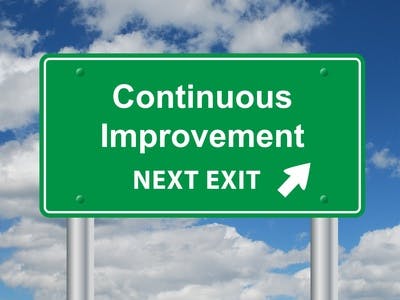“If you’re any good at all, you know you can be better.” — Lindsey Buckingham, American musician
Good enough is good enough, right?
Perhaps that’s true for cleaning your house or writing an email, but as a leader, you know that can be a dangerous attitude. Complacency kills companies, much more quickly and thoroughly than ever before.
You and your team must always strive to get better at what you do, because as Oliver Cromwell put it, “He who stops being better stops being good.”
The benefits of continuous improvement
If Cromwell’s name rings a bell, that’s because he was a master at bettering himself. He rose from relative obscurity in his 40s to become one of the chief politicians of early 17th century England. He participated in the English Civil War as a member of the Parliamentarians or “Roundheads,” rising to a key position in the New Model Army.
He helped remove King Charles I from power in 1649 — and signed the king’s death warrant soon after. By 1653, his peers had appointed him Lord Protector of England, Wales, Scotland, and Ireland. He reigned until his death in 1658.
Cromwell may have taken it to extremes, but continuous improvement definitely has its benefits. It’s become one of the guiding strategies of many modern organizations, in the form of Lean, Kaizen, Six Sigma, and similar philosophies.
If you can install the “always work to be better” mindset as one of your team’s core values, you’ll be a step ahead of those who are content to stand still. How do you do it?
1. Deploy it carefully
Overzealous application of continuous improvement strategies can stifle innovation, if new ideas don’t get the time and resources they need to mature and blossom.
Furthermore, one-size-fits-all approaches never work for everyone. Rather than force them to fit, tailor the initiatives to each team member. Realize also that applying such an initiative can and probably will disrupt existing processes, so ready your folks for the significant changes coming.
2. Take it easy
You don’t have to undertake continuous improvement at a breakneck pace. Incremental improvement is still improvement, and some philosophies (such as Kaizen) emphasize slow development.
I wasn’t able to run my first half-marathon this summer by pushing myself hard a month before the race. It took me a year and a half of constant training and gradual improvement to be able to do it.
3. Involve your team in the implementation
While you can dictate team improvement practices, I don’t recommend it. Instead, be a facilitator and a visionary, smoothing the way and pointing them in the right direction.
Get them on board from the start by asking them to help you define current inefficiencies and problems. Together, search for solutions and determine how best to move forward, clearing obstacles for them as needed.
4. Standardize your practices
To make sure everyone is on the same page and a process is repeatable, document your solutions.
Every time we add a new office procedure, my office manager adds it to our manual. That way, if she departs suddenly, or I need to hire a temp if she falls ill, having these documented procedures will make it easier for me to ramp up the new person.
Also, the team itself stays on the same page, with everyone understanding who does what, when. Our workflow processes move forward like a well-oiled machine, with fewer snags.
The idea is to get everyone to automatically utilize best practices to maximize productivity and minimize waste.
5. Conduct regular post-mortems
Perform reviews of every completed project. A quick email survey or a few questions on surveymonkey.com will allow you to collect information from key players on successes, improvement opportunities, and lesson learned.
Report those results to all in an effort to improve communication, promote team development, and increase effectiveness. Allow time for discussion at the next staff meeting as well.
Open dialog will help the team know what to do and what not to do the next time.
The Big Picture
Of course, this list isn’t the end-all, be-all of continuous team improvement, but it gives you a place to start and a few brass rings to reach for.
Just remember: as with any organizational effort, get frequent reality checks. Are you still going in the right direction? Have the organizational goals and strategic priorities changed? Have you really improved, measured against objective metrics?
If you’ve veered off the path, it’s easy to fix if the diversion occurred just a few days ago, but it’s more difficult if several months have gone by. It’s too late if you end up in Austin when you were headed for San Antonio — and yes, that happened to someone I know.
What would you add to this list? How do you keep the mindset of continuous improvement alive with your team? Is there a practice you regularly employ? Do you have a particular time set aside to discuss inefficiencies?
Please let us know below!
This was originally published on Laura Stack’s The Productivity Pro blog.
